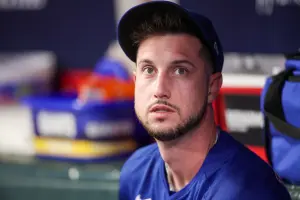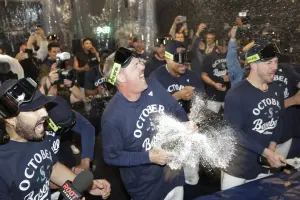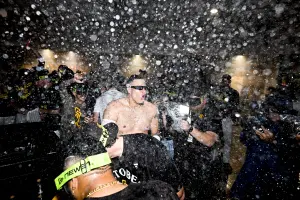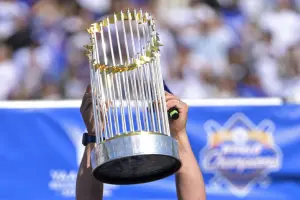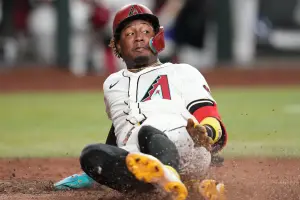
(*) GM's OFFICE: Sitting on your hands
I have a hazy memory of a book I read when I was young. There's a good chance the book involved baseball, since just about everything I read as a kid involved baseball.
In this book, a father is teaching his son how to play chess. With much practice over time, and a lot of games lost to his father, the boy improved as a chess player. As the games with his father got more competitive, the boy found that he was repeatedly done in by a recurring mistake: when it was his turn to move and he was considering possible options, he kept touching the pieces while mulling whether to move them. (In chess, once you touch a piece on your turn, you have to move it.)
The boy had an older brother, who also went through the same cycle of learning chess with his father. The younger brother asked his older brother how to deal with this problem. The older brother responded, "Sit on your hands."
That seems like an appropriate metaphor for how we manage our fantasy teams here in Week 2.
BaseballHQ.com founder Ron Shandler popularized the phrase "practice excruciating patience." He preached that mindset year-round, but particularly at this time of year. Last April, my co-GM Brent Hershey coined another phrase, "April ReSSSistance", to describe our approach to April. From that piece:
The problem, as long-time BasebalHQ.com subscribers, or Baseball Forecaster readers, are familiar with, is the perils of the early stats. It's our nature to grab onto anything consumable—even things as potentially flimsy as April statistics—and try to draw conclusions. But we must resist; all together.
But preparing for the resistance takes discipline. So ahead of the game—now, instead of in one week, or two weeks, or three weeks, when the temptation will be almost unbearable—we present our plan to push back against shallow conclusions from small sample sizes (SSS). It's a two-pronged approach, prepared to get us all through the April numbers doldrums in one piece, and setting the stage for the decisions we'll make over the final five months of the season. Call it BaseballHQ's April ReSSSistance.
Call it what you will: excruciating patience, reSSSistance, sitting on your hands. By any name, we're talking about not overreacting to what we are seeing on the MLB fields over these first couple of weeks.
Maybe it's just that unbearable temptation talking, but to me there is a difference between doing nothing, and acting purposefully. To get back to the chess analogy, the point of sitting on your hands isn't to do nothing forever. After all, it's your move in the game. The purpose of sitting on your hands is just to keep them away from the table until your head has fully processed the situation on the board and decided how to act.
Even here in April, there are decisions to be made. And good decisions are as important now as they are throughout the rest of the season—arguably even moreso, given that you have 24 weeks to reap the benefits of a decision made today.
There's a continuum of decision-making, from the entirely obvious to the entirely indefensible. To cite a couple of actual examples from our Subscriber Forums this week: cutting Clay Buchholz is entirely defensible. Cutting Carlos Gonzalez is not. (To be fair, the latter was a move that happened in a subscriber's league, but not by our subscriber. He was, of course, looking to claim Gonzalez. None of our subscribers would ever cut Carlos Gonzalez after a week. Right?!?)
Over the course of this week, I've faced a couple of decision points that might be typical for your league. I thought it might be useful to explore where they fall on that continuum, and how defensible it is to take your hands out from under your legs and make a move under these circumstances.
Kendall Graveman's two good starts
I bid aggressively on Kendall Graveman (RHP, OAK) as a FAAB pickup in several leagues this past weekend. I wasn't alone: in LABR-Mixed, more than half of the league (8 of 15 teams) placed a bid for him. Is that a case of even industry experts going ga-ga over two good starts? To some extent, yes. In my view, though, it's more about the skills gains (21 swinging strikes in those two starts, backed by a notable velocity gain) than the results (heck, the starts were only PQS-2 and PQS-4). Graveman already had a skills foundation rooted in a healthy FpK and GB%; those and his home park at least establish a decent floor for his value. If you layer some legitimate swing-and-miss ability on top of that foundation, the skill profile quickly gets very interesting. Undeniably, two starts is a tiny sample size. But velocity and SwK are per-pitch metrics, meaning they stabilize faster than, say, HR/FB.
I didn't win Graveman in LABR-Mixed, but I did win him in an NFBC 12-team league. Even in that shallower format, I'm happy to have him. And if he doesn't work out, the downside is just some burned-up FAAB.
Replacing Gary Sánchez or Buster Posey
On Sunday, I did an appearance on SiriusXM with Kyle Elfrink. Gary Sánchez had just been DL'd, so one of Kyle's questions was about waiver wire candidates to replace Sanchez. I mentioned a couple of names, one of whom was Jason Castro. My reasoning was admittedly flimsy: the notoriously contact-challenged Castro had struck out only once in his first 10 AB. On a new team this year, exposed to a different hitting coach, maybe this was a very early sign of a positive adjustment taking route. Heck, he had even had a 4-walk game earlier in the week.
Now, several days later, Castro now has two strikeouts, against nine walks, over 28 plate appearances. How often do you see a 4.50 Eye ratio? Castro could well strike out four times tomorrow, and get his contact rate back to its normal sub-70% level by the time the weekend is out. But for now, if you are fishing for a Sanchez or Posey replacement, or if you found your second catcher in the single-dollar bin, taking a shot at Castro is a low-risk move with at least some early hints of reward.
HQ "darlings": Matt Boyd and Matt Andriese
A pair of young starters who had intriguing UP: projections in the 2017 Baseball Forecaster, Matt Boyd (LHP, DET) and Matt Andriese (RHP, TAM) both had rocky first starts in the opening week. I may sound like an unemotional robot, but I'm not. I own both of these guys in multiple leagues, and I'll admit that I blinked a little bit here, even after just one start. I didn't cut either guy, but I did bench them in a few leagues this week, reducing my exposure to their second starts. Sure enough, Boyd rebounded with six shutout innings in his second start on Monday. Andriese followed suit, with six innings of one-run ball on Thursday night. On the down side, that's 12 innings of one-run ball left on my bench. On the other hand, I still own them both and feel better about that fact now than I did last weekend. Those UPs: are still in play.
The bottom line here is that if you want to get emotional with start/sit decisions, those are much less impactful than add/drop decisions.
Closers: Oakland, Texas, Philadelphia
Less than two weeks into the season, and we already have three changing closer situations. Jeanmar Gómez and Sam Dyson are out, and Oakland seems to be using a true committee approach. It remains to be seen if the altered configurations will stabilize these bullpens. What we do know from our prior research (Closer Hunting Season) is that the sweet spot to see closer jobs change is in the range of Games 21-40. So, if you were hurt by the loss of a Dyson, or bet on Hector Neris only to see Joaquín Benoit get the job, don't fret: we are just a couple of weeks away from the most fertile part of the closer carousel.
When it comes to chasing saves, there's no time to sit on your hands.


